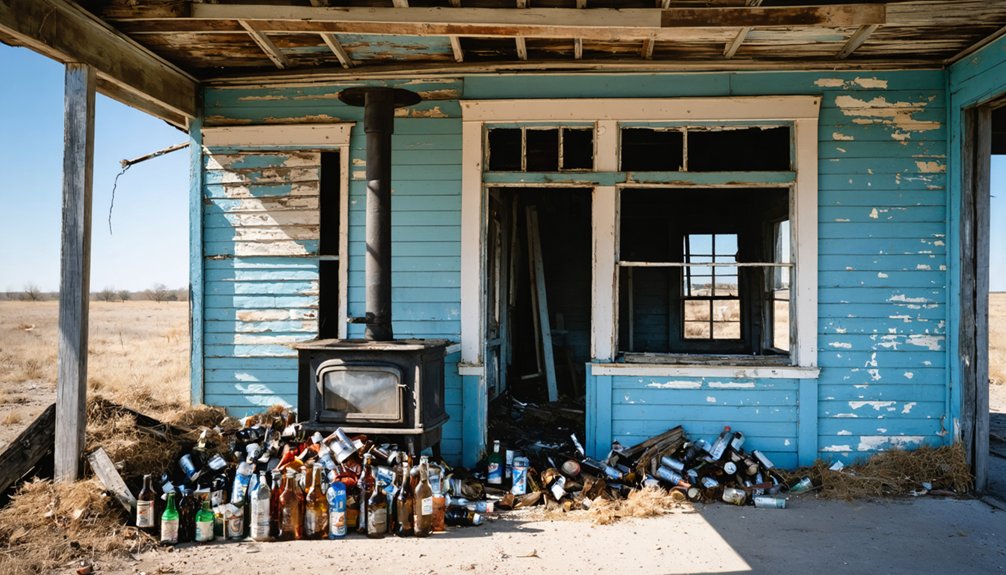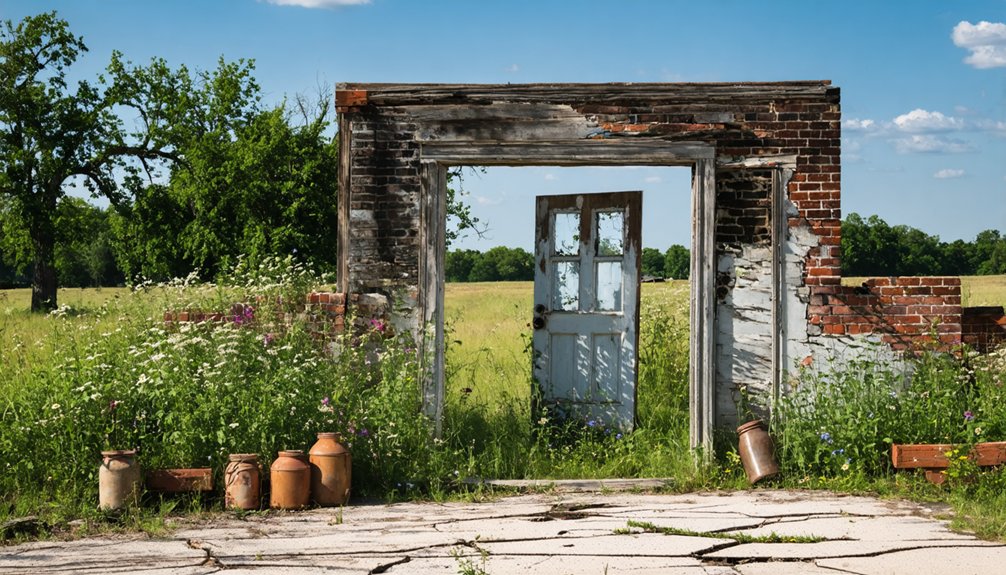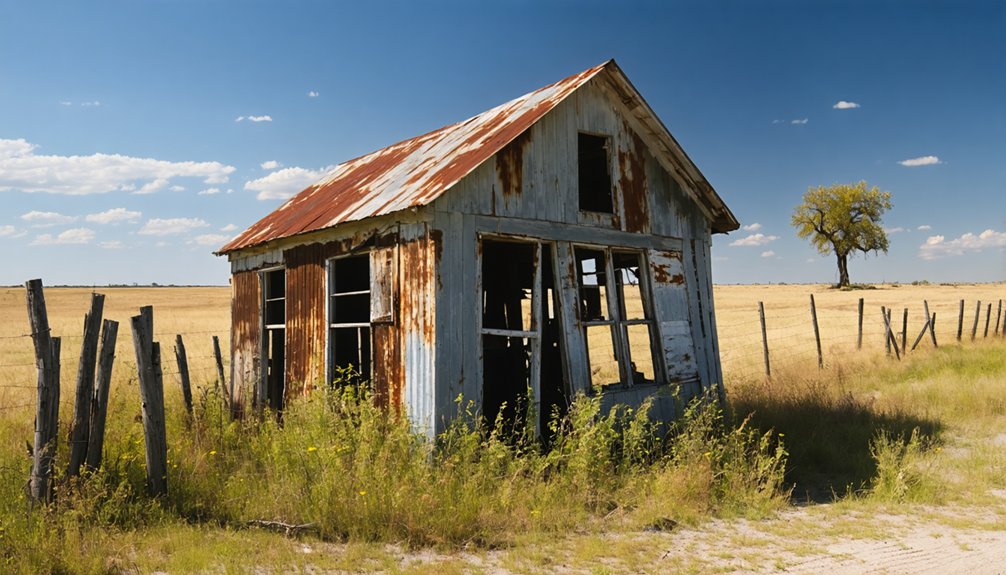You’ll find Tucker, Texas, among the state’s most dramatic oil boom ghost towns. After oil’s discovery in 1924, this modest community of 40 residents exploded to nearly 6,000 people within months. The Powell Oilfield produced 33 million barrels by 1924, transforming Tucker into a bustling hub of commerce and activity. A devastating fire in 1923, followed by the Great Depression and shifting oil operations, led to Tucker’s eventual abandonment. Today, scattered ruins and a cemetery tell a deeper story.
Key Takeaways
- Tucker transformed from a small community of 40 residents to a booming oil town of 6,000 people in 1924.
- A devastating fire in May 1923 and the Great Depression led to significant population decline and business closures.
- The town’s decline accelerated due to southward oil industry shifts and lack of vital railroad connections.
- By the mid-1960s, Tucker’s population dropped back to 40 residents before eventually becoming a ghost town.
- Today, only building ruins, an old cemetery, and scattered foundations remain as evidence of Tucker’s oil boom history.
The Birth of an Oil Boom Town
When oil was discovered across Chambers Creek in January 1924, the town of Tucker emerged as one of Texas’s most dramatic boomtown stories.
The oil town origins trace back to savvy entrepreneurs Tucker and Fullwood, who’d already cut their teeth developing boom towns in the Ranger and Eastland Fields. You’ll find their timing couldn’t have been better – the Humphrey’s McKie #1 well sparked an unprecedented rush that transformed their town site into a thriving hub of nearly 6,000 residents in just months. The town quickly established five grocery stores and numerous other businesses to serve the growing population.
Tucker’s founders positioned their settlement perfectly to serve the bustling Powell Oil Field, where 600 wells pumped out 56,000 barrels daily. This strategic location helped establish the Powell Field’s legacy of producing 186 million barrels, cementing Texas’s position as an oil powerhouse. The discovery followed a pattern seen across Texas, as the state underwent a dramatic economic transformation from its agricultural roots to an industrialized powerhouse.
Life in Early Tucker
Before the dramatic oil boom of 1924, Tucker existed as a modest but close-knit community of roughly forty residents, mainly African American freedmen who’d settled there after the Civil War.
You’d find the heart of their daily life centered around the Green Bay AME Church and the district school, where cultural traditions flourished through religious services, social gatherings, and education. Similar to early settlers in Atascosa County, the community faced Indian raids that tested their resilience.
Their agricultural practices focused on cotton farming, with a steam gristmill and cotton gin supporting local production. The area’s rich sandy loam soil was ideal for growing cotton and other crops. Families supplemented their income through small-scale farming and shared resources.
Despite minimal infrastructure – no electricity or running water – the community thrived through mutual support networks.
You’d witness a culture of hospitality, where homes welcomed visitors, and traditional music enlivened social events.
The Powell Oilfield Legacy
You’ll find the Powell oilfield’s 1900 discovery transformed Tucker from empty ranchland into a bustling town of 6,000 residents within three months.
The Trinity-Brazos Valley Railroad ran alongside the main road, facilitating transportation and commerce for the booming oil town. The oilfield’s development brought unprecedented prosperity to Tucker, spawning businesses from boiler works to theaters while spurring major infrastructure projects like the 1922-1924 Gulf Coast pipeline network. By 1924, the field had produced an impressive 33 million barrels of oil.
Tucker’s oil-driven golden age couldn’t survive the Great Depression, though, and the once-thriving boomtown gradually faded into abandonment despite the broader region’s continued oil production through the mid-20th century.
Oil Discovery Sparks Growth
The discovery of the Powell oilfield in Navarro County, Texas in 1900 transformed Tucker from a quiet ranching area into a bustling boomtown. As oil exploration intensified, population migration brought an influx of workers and entrepreneurs to the region.
You’d have witnessed the town’s explosive growth, with the population reaching 3,000 residents in just two months and doubling to 6,000 shortly after. The area’s oil production soared to peak daily output of 354,893 barrels in late 1923.
The town, founded by Harry L. Tucker on former McKie ranchland, quickly became one of America’s most prosperous oil communities. Similar to Corsicana’s success, Tucker’s oil industry helped establish the region as part of Texas’s first oil boom.
You’d have found a vibrant downtown with essential services including a boiler works, filling station, machine shop, two drugstores, and entertainment venues like a movie house, dancehall, and shooting gallery.
This rapid development showcased the tremendous economic potential that oil discovery brought to Texas’s frontier regions.
Economic Impact and Development
While Tucker’s initial oil boom brought explosive growth, the Powell Oilfield’s lasting economic impact resonated far beyond the town’s borders.
You’ll find its influence shaped Texas’s oil industry infrastructure, accelerating pipeline networks and transport systems that generated billions in economic output. The oilfield’s legacy drove infrastructure development, leaving lasting utilities that communities later adapted for agriculture and manufacturing. The expanding pipeline industry operations created 41,679 direct jobs in Texas by 2013.
The boom sparked economic diversification throughout the region, creating opportunities in construction, transportation, and retail sectors. Local schools and universities benefited from record royalties flowing into educational funds.
You’ll see how oil revenues transformed local governments, funding schools and public works through enhanced tax bases.
While Tucker eventually declined as production waned, the Powell Oilfield’s contributions helped establish Texas as an energy powerhouse, with tax revenues reaching $27.3 billion by 2024.
Community’s Rise and Fall
July 1923 marked Tucker’s dramatic emergence when oil workers and speculators flooded McKie’s former ranch land within the Powell oilfield region.
Within just three months, the population exploded from 3,000 to 6,000 residents, transforming the landscape into a bustling boomtown with drugstores, boiler works, and entertainment venues.
Despite showing remarkable community resilience through the establishment of essential services and social infrastructure, Tucker’s prosperity proved short-lived.
A devastating fire in May 1923 claimed 13 workers’ lives, casting a shadow over the town’s rapid development. The tragedy lives on in historical memory as a sobering reminder of the oil industry’s dangers.
When the Great Depression hit and oil production wavered, Tucker’s vitality faded. Businesses closed, structures were abandoned, and the once-thriving community dwindled into a ghost town.
Daily Living and Community Structure

During Tucker’s brief heyday, you’d find the community’s social life centered around its movie house, dancehall, and various retail shops that served the oil workers and their families.
You could spot hastily constructed housing developments sprawling outward from the oil fields, built to accommodate the rapid influx of workers that swelled the population to 6,000 by early 1924.
While the town lacked formal civic institutions, the filling station, drugstores, and machine shops became natural gathering spots where residents exchanged news and socialized during their off-hours from the oil fields.
Community Gathering Spots
Like many Texas ghost towns of its era, Tucker maintained several essential community gathering spots that served as the lifeblood of daily social interaction.
You’d find community centers strategically positioned throughout the town, where social interactions naturally flourished among residents.
- The general store served as the primary hub for daily provisions and news exchange, becoming an informal meeting place where you’d catch up on local happenings.
- Churches of various denominations hosted weekly services and special events, strengthening community bonds.
- The local bank building, which often doubled as a pharmacy, centralized both financial and medical services.
- Transportation stops, including gas stations with attached stores, created natural gathering points where travelers and locals would intermingle, sharing stories and supplies.
Housing and Neighborhoods
Tucker’s distinctive housing landscape emerged from its roots as a freedmen settlement following the Civil War, with homes scattered across the rural terrain rather than arranged in traditional neighborhood blocks.
You’d have found modest wooden frame houses typical of East Texas freedmen communities, with families often living near small agricultural plots they worked for sustenance.
The housing styles reflected the economic realities of the post-Civil War era, featuring simple construction and limited amenities.
Neighborhood dynamics centered around the Green Bay AME Church, which served as the community’s heart.
You would’ve noticed multigenerational families living in close proximity, fostering strong interpersonal bonds.
While the population remained small – around twenty people by 1940 – the scattered arrangement of homes and reliance on private wells characterized Tucker’s rural identity.
The Decline Years
As the oil industry shifted its operations southwestward, the once-promising town of Tucker entered a prolonged period of decline that would transform it into a ghost town.
Demographic shifts and transportation issues dealt devastating blows to Tucker’s sustainability, with the population plummeting from 60 residents during the Great Depression to just 40 by the mid-1960s.
Key factors in Tucker’s downfall included:
- Missing vital railroad connections while neighboring towns prospered from rail access
- Failing to diversify its economic base beyond oil drilling
- Experiencing closure of schools and social institutions
- Losing younger generations to urban centers with better opportunities
What Remains Today

Today, only scattered remnants hint at Tucker’s former existence as a once-thriving oil town.
You’ll find crumbling foundations and weathered building ruins partially hidden by encroaching vegetation. The town’s cemetery remains as a silent memorial to those who once called Tucker home, while old roadbeds and irrigation ditches trace paths through the landscape.
If you’re exploring the ghost town artifacts, you might discover rusty oil equipment or personal items from Tucker’s heyday.
Local historical societies maintain records, photographs, and maps that document the community’s past.
While there’s no active preservation of the site and no permanent residents remain, Tucker’s story lives on through oral histories passed down by regional families and occasional visitors who venture to explore these remnants today.
Historical Significance and Preservation
The historical significance of this former oil boomtown stretches far beyond its brief existence.
While Tucker’s physical presence was fleeting, its impact on Texas history and American oil culture remains profound.
You’ll find Tucker’s cultural heritage preserved through historical documentation, local museums, and community events at Tucker Town Hall, where residents keep the town’s memory alive.
This Texas ghost town’s story captures essential elements of American resourcefulness and mobility:
- Transformed from ranch land to a thriving community of 6,000 within just six months
- Served as a vibrant social hub with theaters, dance halls, and diverse businesses
- Represents the boom-and-bust cycle common to early Texas oil settlements
- Functions as a case study for scholars examining economic patterns and migration
Though most physical structures have vanished, Tucker’s legacy endures through preservation efforts, oral histories, and photographs that document this remarkable chapter in Texas oil history.
Frequently Asked Questions
Were There Any Notable Crimes or Lawlessness During Tucker’s Oil Boom Period?
Like a lawless frontier, you’d find Tucker followed typical boomtown patterns – lacking crime statistics but experiencing gambling, saloons brawls, and oil theft while law enforcement struggled with the sudden population surge.
What Happened to the Original Buildings and Structures After Abandonment?
You’ll find most structures succumbed to abandonment effects after the oil boom ended, with structural decay taking its toll. Weather and time demolished buildings, leaving only scattered ruins and foundations behind.
Did Any Famous Oil Companies Operate Wells in Tucker?
Powerful pioneers Tidewater and Texas Seaboard Oil Company operated the main wells, while Clinton Manges ran the refinery. You won’t find evidence of other famous oil companies working Tucker’s fields.
Were There Any Schools Established for the Children of Tucker?
You’ll find Tucker had a district school established by 1884, serving the town’s children. Records show education history with school enrollment of around 40 students during the community’s early period.
What Was the Average Price of Land During Tucker’s Peak Years?
While oil brought economic growth, you’ll find land values likely ranged from $50-200 per acre during Tucker’s peak years, soaring well above the pre-boom agricultural prices of $10-30 per acre.
References
- https://en.wikipedia.org/wiki/Tuckertown
- https://en.wikipedia.org/wiki/List_of_ghost_towns_in_Texas
- https://www.treasurenet.com/threads/tuckertown-ghost-town-great-pics.107048/
- https://www.texasescapes.com/EastTexasTowns/Tucker-Texas.htm
- https://www.tshaonline.org/handbook/entries/tuckertown-tx
- https://www.texasescapes.com/TexasHillCountryTowns/Andice-Texas/Tucker-Family-of-Andice-Texas.htm
- https://www.tshaonline.org/handbook/entries/tucker-tx
- https://atlas.thc.texas.gov/Details/5349012341
- https://en.wikipedia.org/wiki/Texas_oil_boom
- https://txnavarr.genealogyvillage.com/towns/tuckertown/tuckertown.htm



